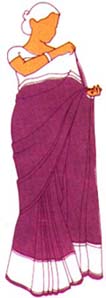Getting ready has got to be half the fun.
I have the perfect slip. I have the perfect earrings and bracelets. I have a wonderful necklace. I’m in a bit of a quandary about my top, though. Should i wear the nude body stocking and a shortie top or something a little more conservative?
Yeah, baby, tonight’s the night.
I’m going to wear my sari for the very first time.
Why a sari? Quite apart from the influence of my East Indian birthplace, I have always been fascinated by this traditional Indian garment. In design, the sari is simplicity itself: it’s nothing more than a rectangular piece of fabric about eight and a half metres by one and a bit. There are no seams. It’s traditionally worn with a very short, snug-fitting blouse, called a choli, that bares the midriff. No haute couture label snobbery here; the sari is worn by peasants and royalty, for everyday and for the most momentous of occasions in a girl’s life.
Saris come in all kinds of fabrics and colours from simple to sumputous. An everyday sari is often made of light cotton, usually printed with an ornamental design in one or two colours. A formal sari, worn for special occasions and weddings will usually be of heavy satin or even silk, with an elaborate design woven in or even hand-embroidered. Gold is a real statement of affluence, and a wide gold-trimmed border makes a very opulent garment that says no expense was spared. No Gucci-label understatement here. Colours are often vivid — mine, for example, is a stunning royal blue with gold. Most saris have one end that’s especially ornate, called the pallav; this is the part that ends up over your shoulder.
So how does such a simple piece of cloth drape and flatter every feminine form without any buttons, pins or fastenings? In short, just how do you wear a sari and what keeps it from all falling off?
Check the slideshow above.
 It takes a little practice to wear, as I discovered. There are a couple of secrets to it. The first essential is the slip. This is basically a full-length half-slip with a drawstring, not an elastic waist. As you wrap the sari you tuck it into the top of the slip so there cannot be any give to the supporting drawstring. I made my own slip in about 15 minutes.
It takes a little practice to wear, as I discovered. There are a couple of secrets to it. The first essential is the slip. This is basically a full-length half-slip with a drawstring, not an elastic waist. As you wrap the sari you tuck it into the top of the slip so there cannot be any give to the supporting drawstring. I made my own slip in about 15 minutes.
Saris are worn in different ways in different parts of India. Although I was born in the north, I learned the southern style first because it’s easier.
 For the southern method, you start with the non-pallav (plainer) end and tuck it into the slip with the end roughly over your right hip and the sari across your front to the left. Adjust it so it’s just less than floor length. Now tuck it once all the way around till you reach your navel, making very sure to keep the length even.
For the southern method, you start with the non-pallav (plainer) end and tuck it into the slip with the end roughly over your right hip and the sari across your front to the left. Adjust it so it’s just less than floor length. Now tuck it once all the way around till you reach your navel, making very sure to keep the length even.

 Now comes the tricky part, and it’s important to get this step right, because the gracefulness of the sari depends greatly on it. Make about 5 to 7 pleats about 6 – 10 cm wide, making sure they’re even in width and the bottom edge is even. Make sure they’re centred, and tuck them in as a group. The part of the sari that came around from behind you should be on the outside of the group of pleats and the free end should be next to your body, so that the pleats open to your left. You may have to repeat this several times until you get everything right. A large safety pin will save beginners a lot of grief at this point.
Now comes the tricky part, and it’s important to get this step right, because the gracefulness of the sari depends greatly on it. Make about 5 to 7 pleats about 6 – 10 cm wide, making sure they’re even in width and the bottom edge is even. Make sure they’re centred, and tuck them in as a group. The part of the sari that came around from behind you should be on the outside of the group of pleats and the free end should be next to your body, so that the pleats open to your left. You may have to repeat this several times until you get everything right. A large safety pin will save beginners a lot of grief at this point.
 You should be left with about 2 metres of sari, including the pallav. Continue wrapping this around you. Make a couple of anchoring tucks over your left hip if you like. Bring the top edge of the sari around from behind you. Gather the pallav together and place it over your left shoulder. The top border of the sari should cross your bust from under your right arm to over your left shoulder. Beginners can pin it in place.
You should be left with about 2 metres of sari, including the pallav. Continue wrapping this around you. Make a couple of anchoring tucks over your left hip if you like. Bring the top edge of the sari around from behind you. Gather the pallav together and place it over your left shoulder. The top border of the sari should cross your bust from under your right arm to over your left shoulder. Beginners can pin it in place.
 The rest of the pallav (there should be about a metre) should drape from your left shoulder across your back, so you can just grasp the end of it in your right hand. Since this is the fanciest part of the sari, the idea is to show it off.With practice you can wrap a sari very quickly and wear it all day without having to re-tuck it or fiddle with it. It requires no more conscious thought to keep it properly in place than does a miniskirt.
The rest of the pallav (there should be about a metre) should drape from your left shoulder across your back, so you can just grasp the end of it in your right hand. Since this is the fanciest part of the sari, the idea is to show it off.With practice you can wrap a sari very quickly and wear it all day without having to re-tuck it or fiddle with it. It requires no more conscious thought to keep it properly in place than does a miniskirt.The choli, or blouse, is usually made of matching fabric. Better saris are often sold with a “blouse piece” preprinted on one end that you cut out and sew yourself. The choli is always snug and always short — part of the appeal of the sari is the bare midriff. Of course, for many of us that’s not a pretty sight and some adaptation is necessary. I wear a regular silk shell that tucks into the slip and covers everything, but a nude bodysuit under the abbreviated choli could also be effective. (You were wondering where that came in, right?)
There are many other ways to wrap a sari. The pallav can be arranged to conceal or show off the waistline in front or back. For example, the northern style reverses most of these directions and the pallav comes forward over your right shoulder or can drape over your head. Farming women in south India wear a much shorter and narrower sari that is knee-length and much more suited to working in the fields. The key to the sari’s versatility is its sheer simplicity.
The sari has a lot of things going for it. Since it’s completely unfitted, it truly fits everyone. You can experiment with it more than with almost any other garment. It makes a wonderful maternity outfit; my mother often wore one when she was expecting me. It’s relatively inexpensive — you pay for the material, not the styling. On the other hand, it has no pockets for keys and can be awkward when you’re making a dash for the bus.
Eight and a half metres of unstitched fabric. Getting ready has got to be half the fun!


